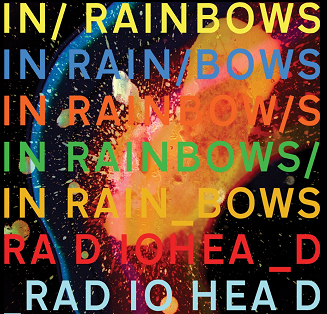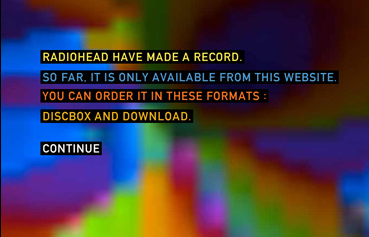
In 2007, Radiohead found itself in a fortuitous position. After finishing a six-album deal with EMI in 2003 they were, as the New York Times put it, “by far the world’s most popular unsigned band.” Unsigned though they were, the band had kept up communications with the A&R team at EMI and the label was hopeful that, in time, they would be able to re-sign the group.
Negotiations came to an abrupt halt when, on 1 October 2007, Radiohead guitarist Jonny Greenwood posted a blog on the band’s website announcing that the new album, In Rainbows, would be released in ten days’ time on a ‘pay-what-you-want’ basis. The album was immediately available for pre-order on the site www.inrainbows.com.
The news was a shock to executives at EMI, who still retained the rights to the band’s catalogue and were hoping to use that ownership to leverage a deal. The band had had enough of the lack of control over their own master recordings and with EMI’s new leadership. They decided they had the critical and commercial success required to, effectively, go out on their own.
In Rainbows was released digitally on 10 October 2007. For the In Rainbows download, Radiohead employed the network provider PacketExchange to bypass public internet servers, using a less-trafficked private network. The download itself was packaged as a ZIP file containing the album’s ten tracks encoded in a 160 kbit/s DRM-free MP3 format. The staggered online release began at about 5:30 am GMT on 10 October 2007. On 10 December, the download was removed. Fans could also pre-order a physical edition from XL Recordings, which was released in December 2007.
The release method itself drew both heavy criticism and praise from all sides of the music industry. Artists like Jay-Z described the release as “genius”, and Courtney Love wrote on her blog: “The kamikaze pilot in me wants to do the same damn thing. I’m grateful for Radiohead for making the first move.” Frontman of the band Nine Inch Nails, Trent Reznor said that the release did not, in fact, go far enough and accused Radiohead of using a compressed digital release as a bait-and-switch to promote a traditional record sale further down the line.
But how did In Rainbows perform? According to Comscore, downloaders paid an average of $2.26 per download globally, and 62% of downloaders paid nothing. Of those who paid, the average paid was $6 globally, with 12% paying between $8 and $12, around the typical cost of an album on iTunes. Another survey, conducted by the industry organisation Record of the Day, found that 28.5% of those who downloaded the album paid nothing or £0.01 and the average price per download was £3.88.
In December 2007, frontman Thom Yorke said that Radiohead had made more money from digital sales of In Rainbows than the digital sales of all previous Radiohead albums combined. In 2009, Wired reported that Radiohead had made an “instantaneous” £3 million from the album. Online music publication, Pitchfork saw this as proof that, thanks to their fans, “Radiohead could release a record on the most secretive terms, basically for free, and still be wildly successful, even as industry profits continued to plummet.”

But how did this gamble come to pay off for Radiohead? Although reports indicated that piracy of the album remained high, sales translated into Radiohead’s highest-ever digital launch. It even allowed Radiohead to take advantage of the novel ways in which music and files are distributed on the internet.
This was especially true in terms of how the band dealt with online piracy. Although the album was available extremely cheaply, download figures across torrent clients, like BitTorrent, were still more than 400,000. This is something that Radiohead’s frontman, Thom Yorke, would consider with the release of his second solo album, Tomorrow’s Modern Boxes in 2014, where the album was available via paid BitTorrent download.
Although the release itself was an exercise in how the traditional power structures of the music industry can be sub-navigated, it didn’t necessarily usher in a sea-change in terms of how music is distributed. The move was a bold first for Radiohead, and although the decision generated a huge amount of buzz regarding distribution, it had little effect on the industry at large.
But what effect did this have on the buzz that it generated for the band? The move was one of the first of its kind. Albums had been released to the public independently before, but they still relied on traditional distribution methods for their rollouts. It positioned Radiohead as a band thinking toward the future of the record industry. They had long been associated with subversive ideals, but this release further cemented their brand as being in opposition to the largely faceless conglomerates controlling the music industry.
Their next release, The King of Limbs (2011), relied on the distribution of a series of fictional newspapers called ‘The Universal Sigh’ which were filled with oblique art and stories by artists like Stanley Donwood. The move ushered in a novel, dynamic approach to album releases that engage the public in interesting ways. In Rainbows is also credited as being the first ‘surprise album’ drop. A move emulated by artists like David Bowie and Beyoncé a few years later
Nonetheless, the decision was idiosyncratic, interesting, and above all, successful. The album performed well both commercially and critically and Radiohead enjoyed a renewed interest in their recorded output. In Rainbows was not merely a musical return to the collaborative approach of the group’s previous albums, but a statement of intent regarding a changing band in changing times. For In Rainbows, the medium was very much the message.


















